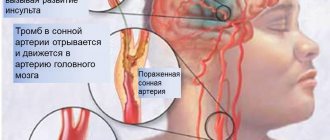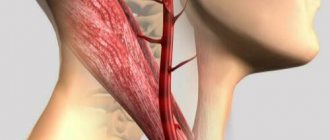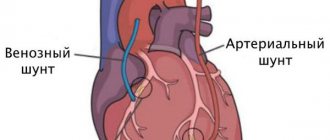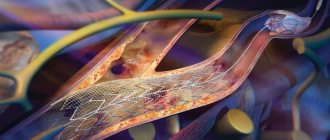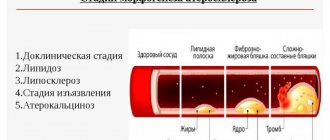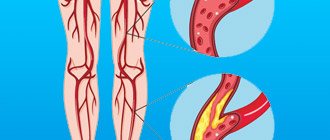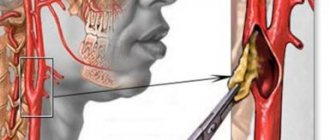Definition:
Atherosclerosis of the carotid arteries is a disease accompanied by narrowing of the vascular lumen of the carotid arteries. As a result of such processes, the required amount of arterial blood does not reach the brain and tissues of the head. Partial or complete blockage of these vessels can cause a brain stroke, which leads to disability or even death of the patient.
The carotid arteries are paired blood vessels located under the skin on either side of the neck. Normally, healthy carotid arteries are flexible and have a smooth surface. If you place your fingers on the skin under your lower jaw on either side of your Adam's apple, you may feel the carotid arteries pulsate. Your carotid arteries carry oxygen- and nutrient-rich blood to the cerebral cortex and other vital brain structures that control body functions. Neck vasoconstriction occurs when the carotid arteries become blocked by fatty, waxy deposits called plaque. The accumulation of plaque in these arteries leads to disruption of blood supply to the brain and increases the risk of stroke, as with atherosclerosis of the BCA, which we wrote about earlier.
Symptoms warning signs of ischemic stroke
Precursors of stroke are symptoms characteristic of chronic cerebral ischemia:
- Headache.
- Dizziness.
- Sleep disturbance.
- Increased fatigue during physical and mental stress.
- Difficulty concentrating and forgetfulness.
- Ringing in the ears or heaviness in the head.
It should be noted that in the absence of adequate treatment, cerebral ischemia progresses and leads to acute cerebrovascular accident (stroke) or contributes to the development of vascular dementia (dementia). Since both atherosclerosis of the cerebral vessels and atherosclerosis of the neck vessels can lead to the above manifestations, the only way to find out the cause is to prescribe the correct treatment for atherosclerosis. This means to ensure reliable prevention of stroke, is to conduct a modern examination.
Causes
The carotid arteries become hardened and narrowed over time due to the constant deposition of plaque, which can restrict blood flow. Plaques are composed of a buildup of cholesterol, calcium, fibrous tissue and other cell breakdown products that are deposited at sites of microscopic damage to the arteries and lead to the formation of a blood clot (thrombus). This process is called atherosclerosis.
Factors that contribute to the development of carotid atherosclerosis and increase the risk of plaque formation and disease development include:
- High blood pressure. Excessive pressure on artery walls weakens them and makes them more susceptible to damage.
- Smoking. Nicotine irritates the lining inside the artery, increasing heart rate and blood pressure levels.
- Age. As we age, arteries become less elastic and more susceptible to damage.
- Increased blood fat levels. High levels of low-density lipoprotein (the so-called “bad” cholesterol) and high levels of triglycerides (blood fats) stimulate plaque formation.
- Diabetes. Diabetes affects not only the ability to process glucose properly, but also the ability to process fat efficiently, increasing the risk of high blood pressure and the development of atherosclerosis.
- Obesity. Excess weight contributes to increased blood pressure, the development of atherosclerosis and diabetes.
- Heredity. If you have atherosclerosis or signs of cardiac ischemia in your relatives, your risk of developing these diseases increases.
- Lack of physical activity. Low physical activity contributes to the development of a number of diseases, including hypertension, diabetes and obesity.
When these risk factors combine, it significantly increases your risk of developing the disease. If you have these factors, make an appointment with your doctor. Your doctor will order a test to evaluate the health of your arteries and recommend treatment and lifestyle changes to reduce your risk of stroke.
Atherosclerosis of the carotid arteries, stroke, transient ischemic attacks (TIA)
What is atherosclerosis of the carotid arteries?
Carotid atherosclerosis is a disease in which there is narrowing or complete blocking of the large blood vessels in the neck, called the carotid arteries.
The carotid arteries arise from the aorta, then pass through the neck and further into the cranial cavity, carrying blood to the brain. Atherosclerosis of the carotid arteries develops more often in older people. Only 1 percent of adults aged 50-59 years have significant narrowing of the carotid arteries, but over the age of 70, 10% of patients have this disease.
Normally, arteries have a smooth and even surface from the inside. But with atherosclerosis, a loose substance consisting of cholesterol, calcium and fibrous tissue is deposited in the artery wall, forming an atherosclerotic plaque, which narrows the lumen of the vessel. Atherosclerotic plaque can grow, significantly altering the normal flow of blood through the artery. In addition, its surface can erode, causing tiny pieces of plaque contents to break off and close the blood vessels of the brain. This leads to the development of a stroke.
The risk of developing atherosclerosis can be significantly reduced by quitting smoking. In addition it is necessary:
- Lead an active lifestyle (regular exercise)
- Follow a low cholesterol diet
- Control your weight
If you have diabetes, high blood pressure, or high blood cholesterol, you need to take a number of additional measures to reduce the risk of developing atherosclerosis.
What are the symptoms of the disease?
Atherosclerosis of the carotid arteries may not manifest itself in any way in the early stages. Unfortunately, very often the first manifestation of this disease is a stroke. However, in a number of patients, the development of stroke is preceded by so-called transient ischemic attacks (TIA). In this case, temporary symptoms of impaired cerebral blood supply appear (lasting from several minutes to 1 hour):
- Feeling of weakness, numbness, or tingling on one side of the body, such as the right arm and leg
- Inability to control movements in an arm or leg
- Loss of vision in one eye
- Inability to speak clearly
These symptoms usually go away completely within 24 hours. However, you should not ignore them.
The appearance of the above symptoms means that there is a very high risk of developing a stroke. You must consult a doctor immediately. If such symptoms do not go away within several hours, this indicates the development of a stroke. You must consult a doctor immediately.
What research needs to be done?
During the conversation, the doctor should tell you about your complaints, as well as whether you smoke or not and whether you have high blood pressure.
The doctor will also ask when and how often complaints appear. During the examination, the doctor will use a phonendoscope to listen to the area above the carotid arteries, as noise appears when blood passes through the narrowed vessel.
To confirm the presence of atherosclerosis of the carotid arteries, a special study is performed - duplex scanning. In most cases, this study is enough to determine how damaged the arteries are and choose a treatment method. However, in some cases it is necessary to perform a computed tomography (CT), magnetic resonance imaging (MRI), or angiographic study.
Treatment
The choice of treatment method is made based on data on the degree of damage to the carotid arteries, the presence or absence of symptoms, and the general condition of the patient is also taken into account. In the early stages, a specialist may recommend medication and lifestyle changes.
If there are concomitant diseases that accelerate the development of atherosclerosis, additional recommendations will be given. For example, with diabetes, it is necessary to control normal blood sugar levels. If you have high blood pressure, your doctor will prescribe medications to normalize it. If you smoke, you need to quit. If blood cholesterol levels are elevated, you must follow a special diet, and sometimes special medications (statins) are prescribed to lower cholesterol levels.
Surgery
If there is significant damage to the carotid arteries, surgical treatment may be required. Signs of a serious illness include transient ischemic attacks and a recent stroke. However, a significant number of patients may have no complaints even with very severe damage to the carotid arteries.
The surgical operation consists of removing the atherosclerotic plaque. This procedure is called a carotid endarterectomy.
As our experience shows, this operation, in the hands of experienced specialists, is quite safe and, as a rule, is not accompanied by complications.
Endovascular techniques
Along with traditional operations for atherosclerosis of the carotid arteries, newer treatment methods can be used. These include balloon angioplasty and stenting.
The method is that through a small puncture of the artery on the thigh or shoulder, a long narrow tube called a catheter is inserted into the lumen of the carotid artery. The catheter is passed to the site of narrowing of the vessel, where a special metal device - a stent - is installed. The stent expands the lumen of the artery and serves as a scaffold that maintains normal patency of the vessel.
Currently, this technique is used mainly in patients with significant concomitant diseases (for example, heart failure), for whom conventional surgery is associated with a high risk of complications.
What should you do to stay healthy?
Lifestyle changes can stop the progression of carotid atherosclerosis. The first step is to quit smoking. Controlling obesity, regular exercise and a low-cholesterol diet can significantly reduce the risk of developing atherosclerosis.
Symptoms
Because carotid atherosclerosis develops slowly and is often asymptomatic, the first manifestation of this disease may be a stroke or transient ischemic attack (TIA), sometimes called a mini-stroke. TIA causes stenosis of the carotid arteries: they are accompanied by headaches, short-term loss of vision and speech impairment, numbness of half the body and limbs.
A stroke or TIA is a medical emergency. If you or a loved one shows signs or symptoms of a stroke, call emergency medical services immediately. Do not try to get to the hospital on your own. Warning signs and symptoms include:
- Sudden numbness or weakness in the face and limbs, often on only one side of the body
- Loss of ability to move limbs
- Impaired speech and understanding of the meaning of someone else's speech
- Sudden loss of vision in one or both eyes
- Dizziness or loss of balance
- Sudden severe headache without a specific cause
Complications
The most serious complication of carotid atherosclerosis is stroke. The increased risk of stroke in patients with carotid artery disease is due to the following factors:
- Decreased blood flow. Carotid arteries with atherosclerosis often narrow to such an extent that they do not provide sufficient blood flow to the brain.
- Plaque rupture. There is a risk that part of the plaque will break off and penetrate the small arteries of the brain (cerebral arteries). A fragment lodged in one of these small arteries will block it. This will impede blood flow to the area of the brain that is supplied by this artery.
- Thrombosis. Some plaques are prone to cracking and forming an uneven surface on the artery wall. The body reacts to these changes as if it were damaged and sends platelets to this place - blood cells that participate in the process of blood clotting. A blood clot may form that is large enough to block or slow blood flow through the carotid or cerebral artery, causing a stroke.
A stroke causes permanent brain damage and muscle weakness, and in severe cases, death.
Diagnostic methods
- Medical checkup. A “whooshing” sound (murmur) above the carotid artery in the neck when auscultated indicates a narrowing of the carotid artery. Your doctor will examine your physical and mental health, such as muscle strength, memory, and speech function. To begin treatment for arterial stenosis, one examination is not enough: instrumental examination methods will help to assess the condition.
- Ultrasonography. A non-invasive method for detecting atherosclerosis of the carotid arteries is Doppler ultrasound. This test evaluates blood flow, pressure, and constriction of a blood vessel by recording high-frequency sound waves (ultrasound) bouncing off red blood cells.
- Computed tomographic angiography (CTA). This imaging test uses a contrast agent to highlight the carotid arteries in the images. A contrast agent is injected into a blood vessel. Once it enters the carotid arteries, a computed tomography (CT) scanner takes X-rays of the neck and brain from different viewing angles.
- Computed tomography (CT) of the head. This imaging method allows you to examine brain tissue without the introduction of contrast agents and exclude the presence of bleeding and other disorders.
- Magnetic resonance angiography (MRA). Like CTA, this imaging test uses a contrast agent (without iodine) to highlight the arteries in the neck and brain. A magnetic field and radio waves are used to create three-dimensional cross-sectional images.
- Magnetic resonance imaging (MRI). This imaging technique looks at brain tissue to help detect early signs of stroke or other problems.
- Angiography of cerebral vessels. This traditional invasive method is rarely used because this examination increases the risk of stroke. As with cardiac angiography, during the procedure a contrast agent is injected using a catheter placed directly into the carotid arteries. Then x-rays are taken.
Treatment methods
What treatment methods can reduce the risk of complications due to atherosclerosis of the carotid arteries? In the early stages, drug therapy is effective: for cerebral vascular diseases, medications that reduce blood viscosity and lower cholesterol levels are prescribed. If the vascular lumen is blocked to a significant extent, the solution may be surgical intervention:
- angioplasty and stenting of the carotid arteries are modern and painless ways to restore the vascular lumen and normalize blood flow in atherosclerosis.
- Carotid endarterectomy is an operation to remove plaque from the carotid artery, performed under anesthesia through a small incision in the neck.
Read more about methods of treating atherosclerosis of the carotid arteries in the following publication.
Favorite spots for plaques
Most often, atherosclerotic plaques are located in the following places:
- in the area of the bifurcation of the carotid artery, i.e., where the common carotid is divided into external and internal;
- at the mouth of the ICA – the initial segment of its branch from the ECA;
- at the mouth of the vertebral arteries;
- in the ICA siphon (the place of bend at its entry into the skull).
This is explained by the fact that in these places, due to the unevenness of the vessel, a turbulent (vortex) blood flow is created, which increases the likelihood of endothelial damage.
